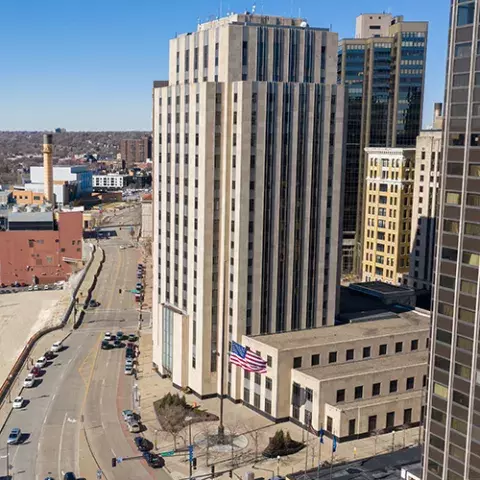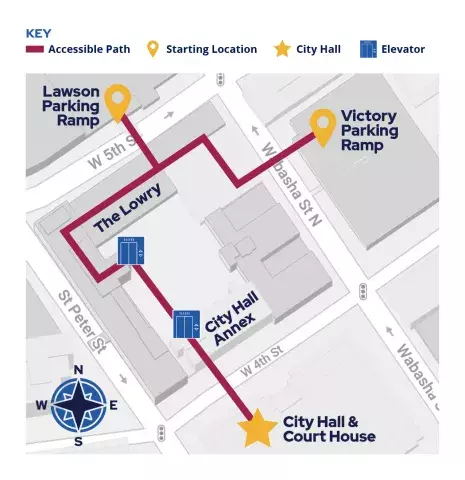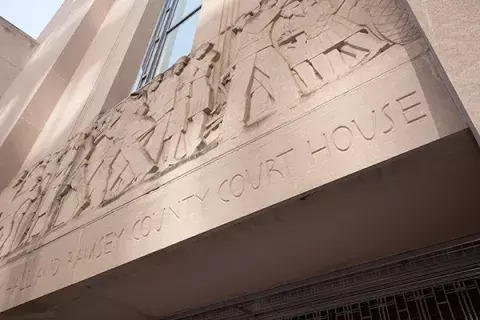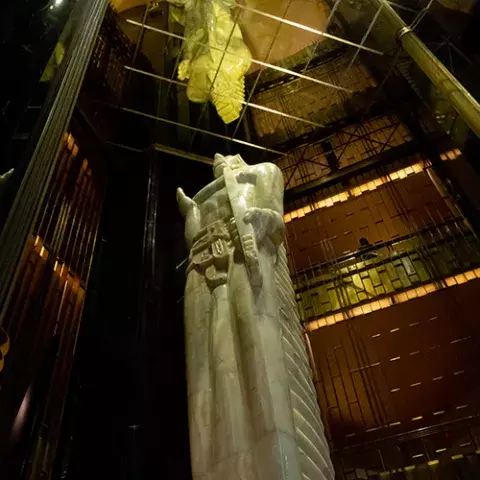Architectural Highlights
The Exterior
The 20-story City Hall was built in the American Perpendicular style from Indiana limestone and Wisconsin Rosetta black granite. A three-story base step back to the central tower accentuated by thin vertical lines of dark windows and connecting spandrels, which give the building a soaring appearance. A series of reliefs by New York sculptor Lee Lawrie highlight the main entrances.
Exterior Reliefs
Immediately above the Fourth Street entrance, a City street scene shows a police officer, a mail carrier, a newspaper boy, a mother and daughter, a blind man, and elderly couple, and a laborer — representing the diversity of urban dwellers. A traffic light, and automobile, and a fire hydrant are included to indicate the benefits of modern technology to the City resident. Above the street scene relief, a tall, narrow window runs up to a monumental female figure symbolizing liberty. She holds an open book inscribed vox populi and jus civile to reflect traditional government ideals.
Three small reliefs of City, County, and State emblems continue around the building at street level. The City of Saint Paul is represented by a mural crown and a Roman sword. Ramsey County is represented by the washstand on which Governor Ramsey wrote the territorial proclamation and the scroll of the proclamation. An eight-pointed image of the North Star represents the State of Minnesota.
Limestone reliefs flank the Kellogg Street entrance, again reflecting the ideals of government and modern industrial society. A goddess holding a staff with two entwined serpents represents civic government. She holds balanced scales inscribed law and order. An open book, a nail keg, and a cogged wheel — inscribed education, commerce and industry — reflect modern urban ideals. A panoramic view of the City of Saint Paul, including the City Hall and Courthouse building, is depicted behind the goddess.
Rural life in Ramsey County highlights the relief to the right of the entrance. A female figure holding a scythe over a bundle of wheat inscribed agriculture stands in front of a landscape of pine trees, mountains, and a rising sun. A train bannered transportation reflects ties between City and country made possible by modern technology.
Two small reliefs outside of the main panels complete Lawrie’s work. To the left is a balanced scale representing justice, and to the right, a calumet symbolizing peace.
The Interior
In contrast to the stark monochromatic exterior, the interior of the Saint Paul City Hall and Ramsey County Courthouse was designed in the more jazzy, ornate Zigzag Moderne, an art deco style derived from a 1925 Paris art exhibition. The art deco theme is used throughout the building, even down to such details as door handles, light fixtures, stair railings, and the lobby mailbox.
Memorial Hall, dedicated to the Ramsey County soldiers who died in 20th Century wars, measures 85 feet by 21 feet and extends upward for three stories. Blue Belgian marble, gold mirror ceiling, and sixteen hollow bronze shafts set in marble columns and lighted from within all serve to highlight the hall's most spectacular feature — the Vision of Peace.
Vision of Peace
Swedish sculptor Carl Milles, a pacifist, was deeply impressed by a Native American ceremony he witnessed in Ponca City, Oklahoma. Memories of that ceremony were a dominant influence when he created the statue, “Vision of Peace.” Although there is no connection between Native American spirituality and his own vision, Milles depicted five Native Americans seated around a fire and holding their sacred pipes. Emerging from the smoke of those pipes is a “god of peace” which Milles imagined speaking to “all the world.”
The statue weighs approximately 60 tons, stands 36 feet high, and was carved from Mexican onyx using Milles’ full-scale model. The statue sits on a revolving base which can be turned 66 degrees to either side of center. There are 98 sections fastened to a steel I-beam and supported by three-quarter inch bronze ribs. The statue was unveiled on May 28, 1936, and named Vision of Peace in 1994 at a special community ceremony involving three major Minnesota Native American tribes.
Interior Artwork
The third-floor Council Chambers, finished in English oak and furnished with woods from Eastern and Western Europe and Africa, features four giant murals painted by John Norton, a Chicago painter associated with the Prairie School architects. Using a style known as WPA Moderne, Norton depicted the founding and growth of Saint Paul. The south wall has scenes of the voyageurs and their relations with the Native Americans, and a steamboat captain from the days before railroads came to Ramsey County. The murals show the beginning of the railroad era, featuring a surveyor; and modern industry and progress, with the major figure celebrating labor.
Similar themes of history and industrial growth characterize relief sculptures on the elevator doors in the first-floor lobby. Six bronze doors were designed by New York artist Albert Stewart. Using a flat relief style, Stewart portrayed and Indian and tee - pee, a black slave working along the Mississippi, a farmer, a factory, a train, a Bunsen burner, a worker carrying a power tool, and the Saint Paul City Hall and Ramsey County Courthouse itself.
When the building was renovated in 1993 a basement concourse-level exhibit space and meeting rooms were added, as well as a commons area, which was decorated with sandblasted and etched glass murals featuring old and new scenes of the City and county. They were created by New York artists Denise Amses and Christopher Cosma.



